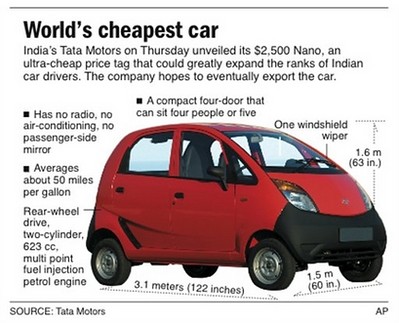Tata Motors sends executives on an environmental tour to Europe – looks to raise eco-awareness;
(Source: Autobloggreen & Financial Times)
Executives at India’s Tata Motors admit that their company is a bit behind the times when it comes to environmental awareness when compared to established players in Europe. “We are behind as far as the world is concerned. There are many Scandinavian companies because they are more conscious of this than the rest of us,” says JJ Irani, a director for Tata’s automotive business. He adds, “We are not shy of learning.”
“Tata is new at this game,” Mr Irani told the Financial Times, explaining that the Indian group had not concentrated much on environmentally friendly products until now.
“What we wanted was the experience of other global conglomerates who have been on this journey before,” he said.
For this reason, Irani and a few of his colleagues are currently visiting a number of large European companies in an attempt to pick up a few pointers on how to improve their eco-credentials. In addition, the group has plans to meet with executives at some of the world’s largest oil companies. Irani hopes these meetings will allow Tata to “catch up faster” than if they were on their own. Mr Irani said he was taking managers from Tata companies to see how other groups behaved. “We want to see what sort of problems they face and how they deal with it so we can catch up faster.”
Tata has come in for heavy criticism from some environmentalists about the Nano, the world’s cheapest car, but the Indian company retorts that it is more fuel-efficient than a motorbike.
Tata sees a big opportunity because it operates in some of the biggest polluting sectors such as power generation, steel manufacturing and chemicals and carmaking. It has set up a group dedicated to exploring ways of becoming more environmentally friendly and has about 100 people working on it across all its companies.
The Tata managers will also meet some grandees of the oil industry including Lord Browne, the former BP chief executive, and Lord Oxburgh, ex-chairman of Shell.
They will also visit executives at banks Standard Chartered and Deutsche Bank as well as Siemens, Europe’s largest engineering group.
On a related note, TATA is releasing its all-electric Indica for the Norwegian market and eventually for the rest of the world.

Although the all-electric Tata Indica on display at the SAE World Congress in Detroit this week is not the soon-to-be-released model, there’s a lot we can learn from the vehicle – and from TM4’s Eriz Azeroual – about how the technology will be implemented when the new model goes on sale in Norway either later this year or in early 2010 (yes, this is later than previously expected). A limited number of the Indica’s are already testing in Norway and the TM4 reps are heard saying that Tata Motors is “a cool company. Very aggressive.” Even though they’re most famous for the Nano and apparently wanting to dominate the low-end automobile market, in Europe market they want to be known for electric vehicles. Norway is a perfect entry point to bring an EV to Europe because there is a high tax on gasoline-powered vehicles. The high cost of electric vehilces isn’t totally equalized by the taxes, but EVs and gas-powered vehicle prices end up being “comparable” in Norway.


![Spain's system of 218-mile-an-hour bullet trains, the AVE[mdash ]meaning 'bird' in Spanish[mdash ]has increased mobility for many residents, though critics say it has come at the expense of less-glamorous forms of transportation.](http://s.wsj.net/public/resources/images/NA-AX208_FASTRA_G_20090419183055.jpg)





